
Know-how About Sails
Step-by-step guide: how to sail a code zero on a catamaran.

- About Sails , Multihull
- Catamaran , Code Zero , Multihull Sails , Video
Flying a Code Zero on a cruising catamaran
Handling a Code Zero sail on a modern cruising catamaran: This informative and inspiring how-to-video was made by the Australian multihull experts of TMG Yachts , after taking delivery of a new Rolly Tasker Sails Code 0 . This sail was tailor made for the Lagoon 46 catamaran featured here by Rolly Tasker Sails Australia . So, for the exhilarating experience of flying a Code Zero sail , come along on board and learn how to safely and efficiently handle this exciting sail on this special type of boat with this clear and concise step-by-step guide.
What Is a Code Zero or Code 0?
In this video, Joe Fox of TMG Yachts not only shows the practicalities of sailing with a Code Zero, but he also explains the difference between a Code Zero and an asymmetrical spinnaker . He then takes us through all the steps in setting up and preparing the Code 0, including some finer points like, for example, halyard tension.
The Code zero sail is somewhere between a large Genoa and an asymmetrical spinnaker . Lighter and larger in area than the Genoa, it is also furled . It is however a true downwind sail , made for broad reaching .
Code Zero Practicalities
When do you best fly your Code Zero ? Learn about wind range and wind angles most suitable for this beautiful sail. The video also gives a very detailed and clear step-by-step guide to hoisting and unfurling the sail . Once it is up and pulling, learn all about the perfect trim and how easy it is to gybe this sail in relaxed cruising mode.
As already said, the Code Zero is a downwind sail for up to 150 degrees or so off the wind. It is not suitable for any courses closer to the wind than a beam reach. And even the beam reach should only be sailed with the Code 0 in really light winds – especially on a catamaran, there is huge pressure on the rigging, and you do not want to over-power that. For a cruising cat, Joe recommends the wind speed limit for a Code Zero at 15 to 20 knots . And the stronger the wind is, the lower off the wind you should sail.

Feel the Thrill
This video is great fun to watch, it will inspire you and make you want to get out on the water now to experience the thrill of fast sailing! The Code Zero sail can really turbo charge your cruising catamaran , adding several knots of speed, especially in light airs. However, apart from literally showing you the ropes of how to do it, it also points out potential problems when you are not taking care …
Have fun both when watching the video and also, of course, out on the water!
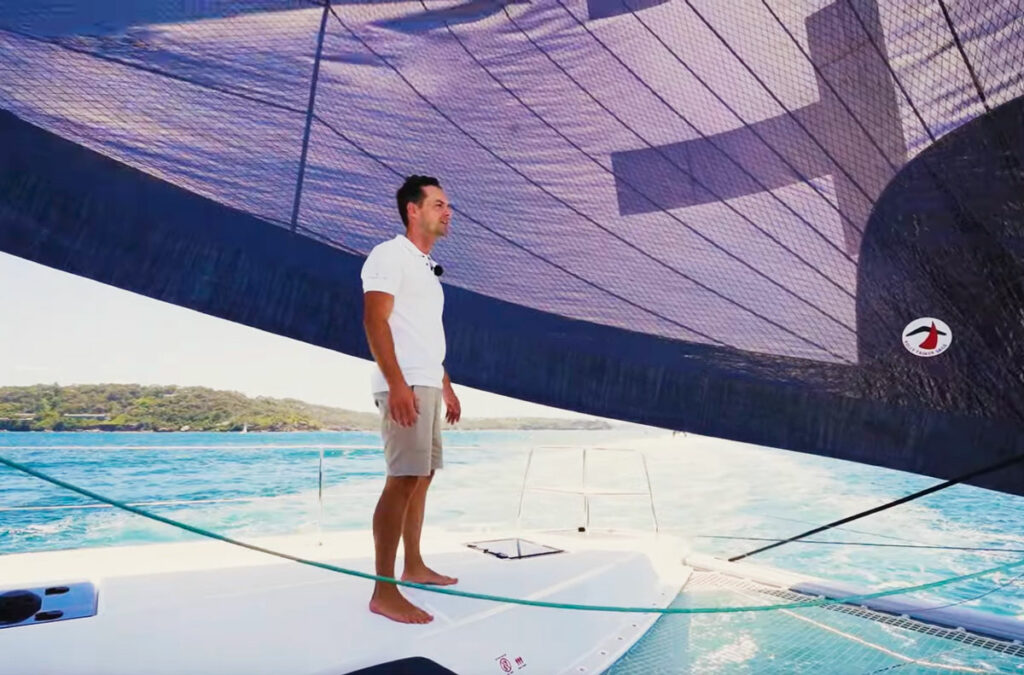
Do You Like this Content?
Hop on our list and be the first to find out about the best sailing tips, news and special offers.
Related Posts

New Sails for a Classic Cruising Ketch on Circumnavigation
Klaus Hohberg and Dr. Tilly Eichler from Germany are sailing around the world on their beautiful Jongert Ketch “Lapita”. Klaus

Buying New Sails Is Like Buying a New Boat!
Said James Frederick, currently slowly solo sailing around the world onboard his 1965 built Alberg 30 sloop, SV Triteia, “in

The Catamaran Designs of James Wharram
James Wharram is known for his characteristic multihull designs that have enabled thousands to follow their dreams of building and
We prioritize quality and sustainability, as it directly influences not only our customers' satisfaction and safety but also the well-being of our sailmakers and the environment. Sailing is an experience in nature, which is why crafting sails should be done with the future of our planet in mind.
Services for Sailors
In our sail-loft in Phuket, we make new sails – and offer other services for anything from the deck up on your sailing boat:
- Chandlery for deck and rigging hardware
- Spars and rigging services
- Cordage and running rigging
We also have an extensive network of local dealers around the world, bringing our service nearer to you.
Most Popular Sails
Let's stay in touch, latest news, beautiful classic gaff ketch cariad with full suit of rolly tasker sails, meet youtube sailing star eric aanderaa at our stand during boat show “boot 2024” in germany, viking explorers rally 2024 and rolly tasker sails, most read posts.

Quick Links
Legal pages, © 1949 –2024 rolly tasker sails – international sailmakers.
How to Fly a Code Zero on a Catamaran
Inspire and learn sailing techniques.
Welcome to another Inspire and Learn guide, brought to you by TMG Yachts. In this instructional piece, we delve into the intricacies of flying a Code Zero on a catamaran, specifically the Lagoon 46. Join our expert, Joe Fox, as he walks you through the setup, preparation, and manoeuvres involved in harnessing the power of this versatile sail.
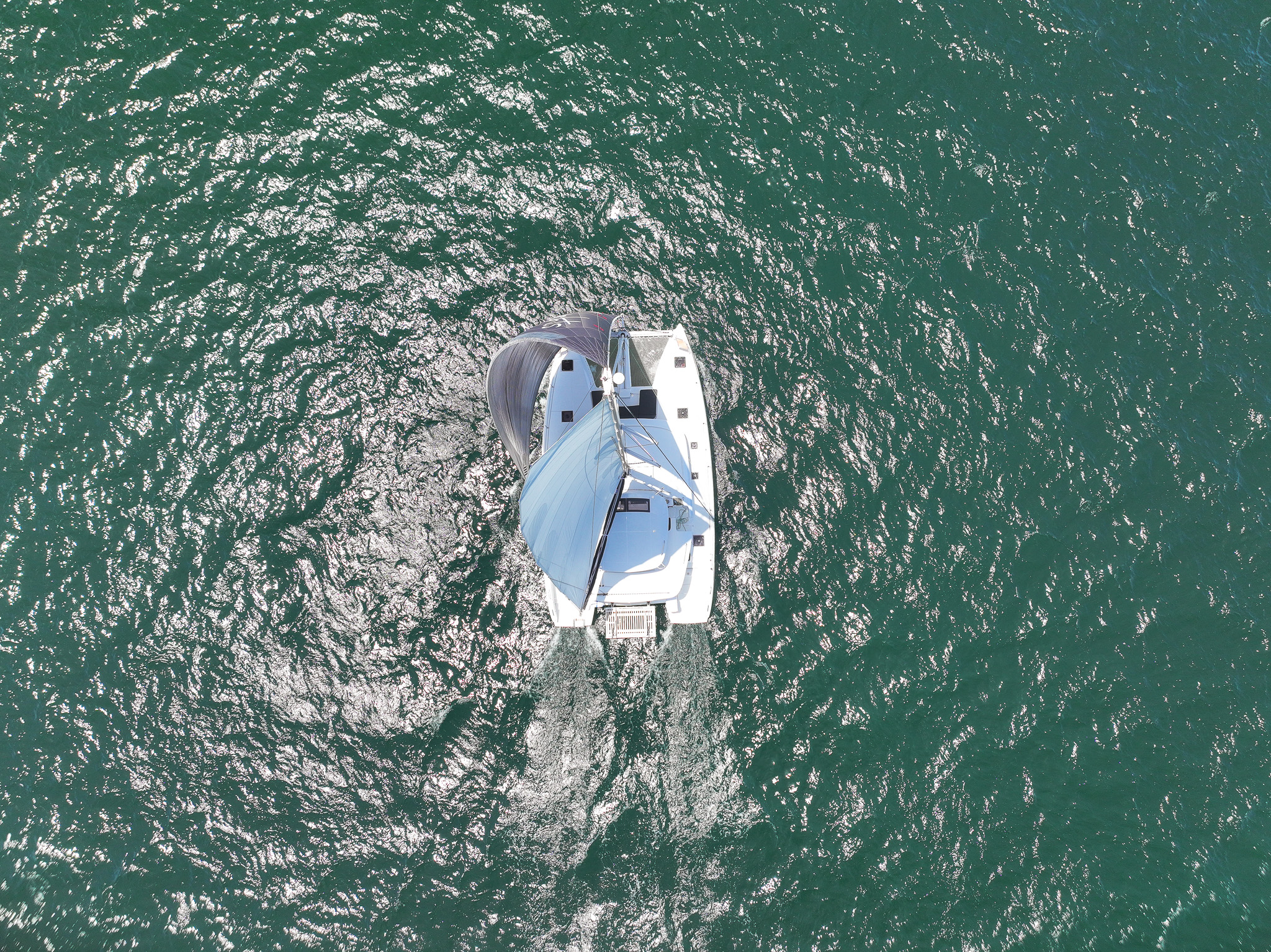
Code Zero Hoisting
Before hoisting the sail, make sure all fixing points are attached, including the sheets and halyard. Hoist the sail from the helm station, ensuring that the halyard is tightened sufficiently. Be mindful of the wind direction, as it may push the sail against the rigging during hoisting. Once hoisted, secure the sheets and ensure the furling mechanism is engaged to prevent accidental unfurling.
Before Using the Code Zero
Before turning away from the wind to utilize the Code Zero, it’s crucial to prepare the sail for unfurling. Ensure that the mainsail is fully hoisted. Run both the port and starboard sheets up to the winches for control. It’s essential to ensure that all lines are free to run, especially with the potential pressure from the wind. Load the working sheet onto the winch corresponding to the side from which the sail will come out and ensure that the lazy sheet on the opposite side is completely free to run to prevent disruption during unfurling.
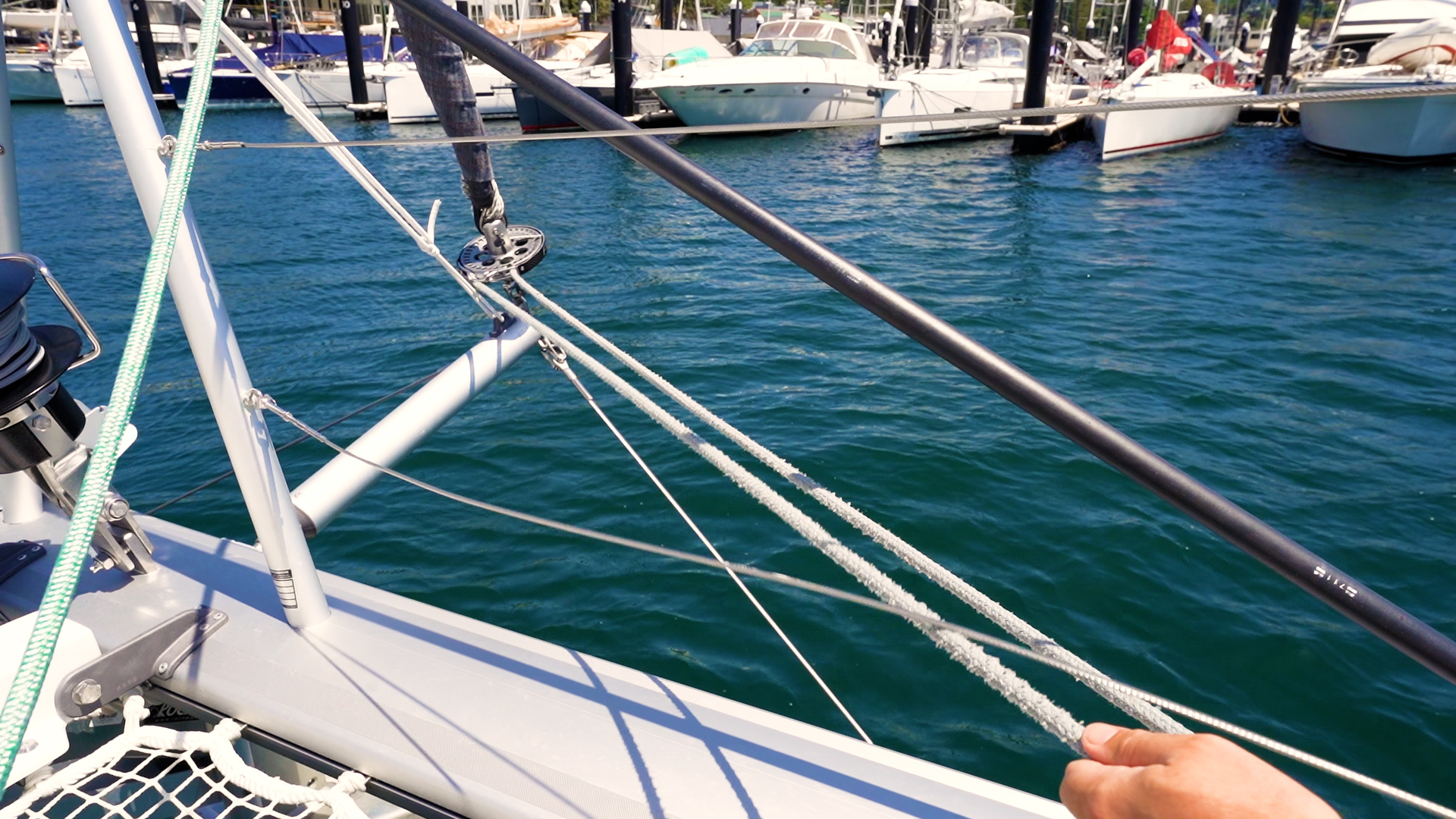
Trimming the Code Zero
Once the Code Zero is unfurled, trimming becomes essential to optimize its performance. Similar to trimming a Genoa, pay attention to the tell-tales on the windward and leeward sides of the sail. Adjust the sheets accordingly to achieve optimal sail shape and efficiency. Be mindful of the wind angle and adjust the trim as needed to maintain the desired course and speed.
WATCH TRIM VIDEO HERE
How to Gybe – Cruising Gybe vs Racing Gybe
Since the Code Zero is primarily a downwind sail, tacking is not possible, as the sail is hoisted in front of the forestay , instead you must gybe .
For a cruising gybe, start by heading downwind to reduce the apparent wind on the vessel. Ensure the furling line is ready, and as the sail is eased, furl the sail, then prepare to gybe the boat. Once the gybe with the mainsail is complete, and the boat is on its new trajectory, unfurl the Code 0 sail on the opposite side to continue sailing downwind smoothly.
For those with more advanced skills or experience in racing, a racing gybe can be executed. This involves threading the sail between the Code Zero itself and the forestay without furling the sail , requiring precise timing and technique to ensure a smooth transition
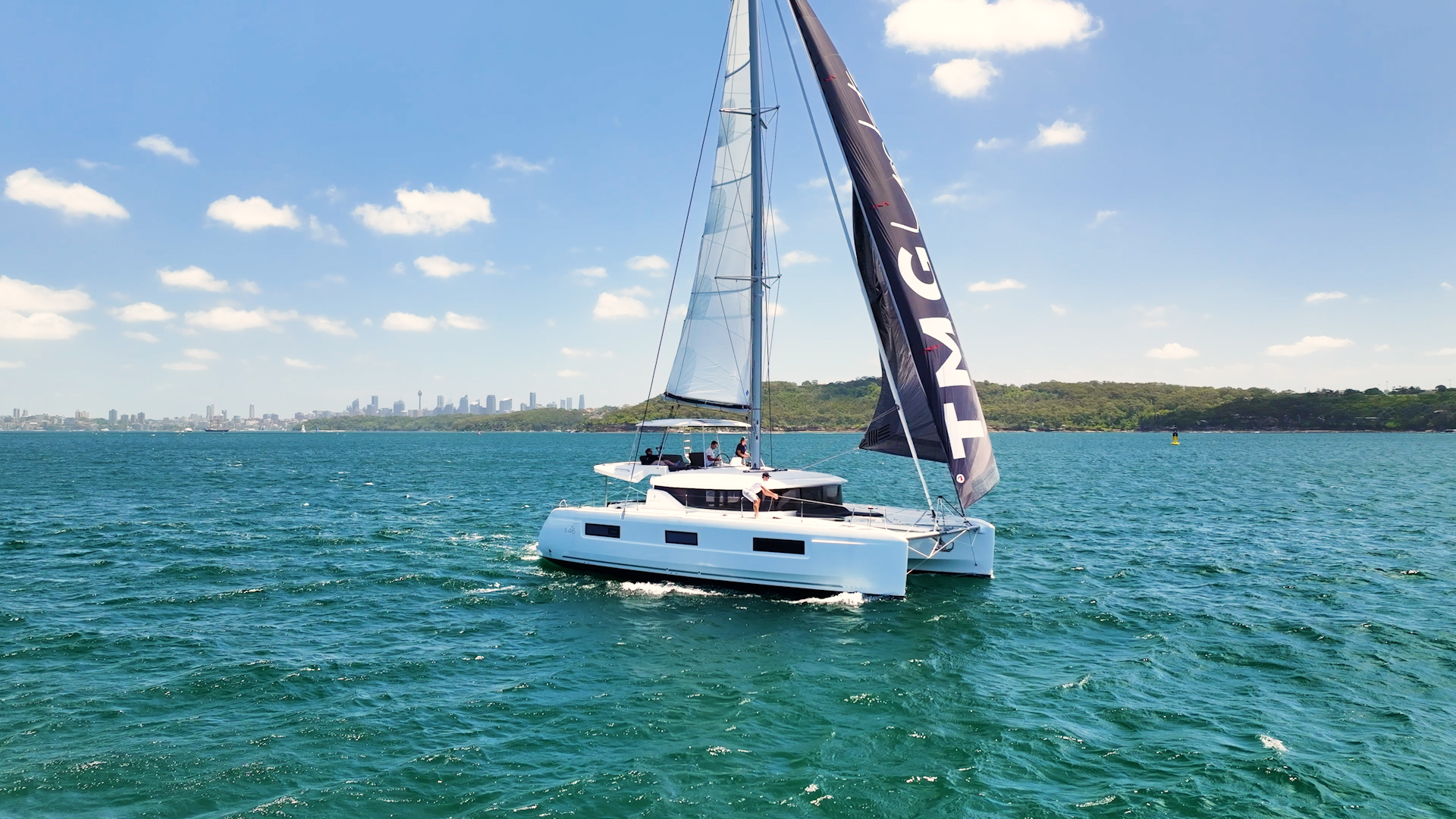
Flying the Code Zero is an exhilarating experience that can significantly enhance sailing performance in light wind conditions. While it requires careful planning and maneuvering, mastering the use of the Code Zero opens up new possibilities for sailors seeking to maximize their speed and enjoyment on the water. Whether cruising or racing, the Code Zero is a versatile and valuable addition to any vessels sail wardrobe.
LATEST FROM THE INSPIRE AND LEARN SERIES
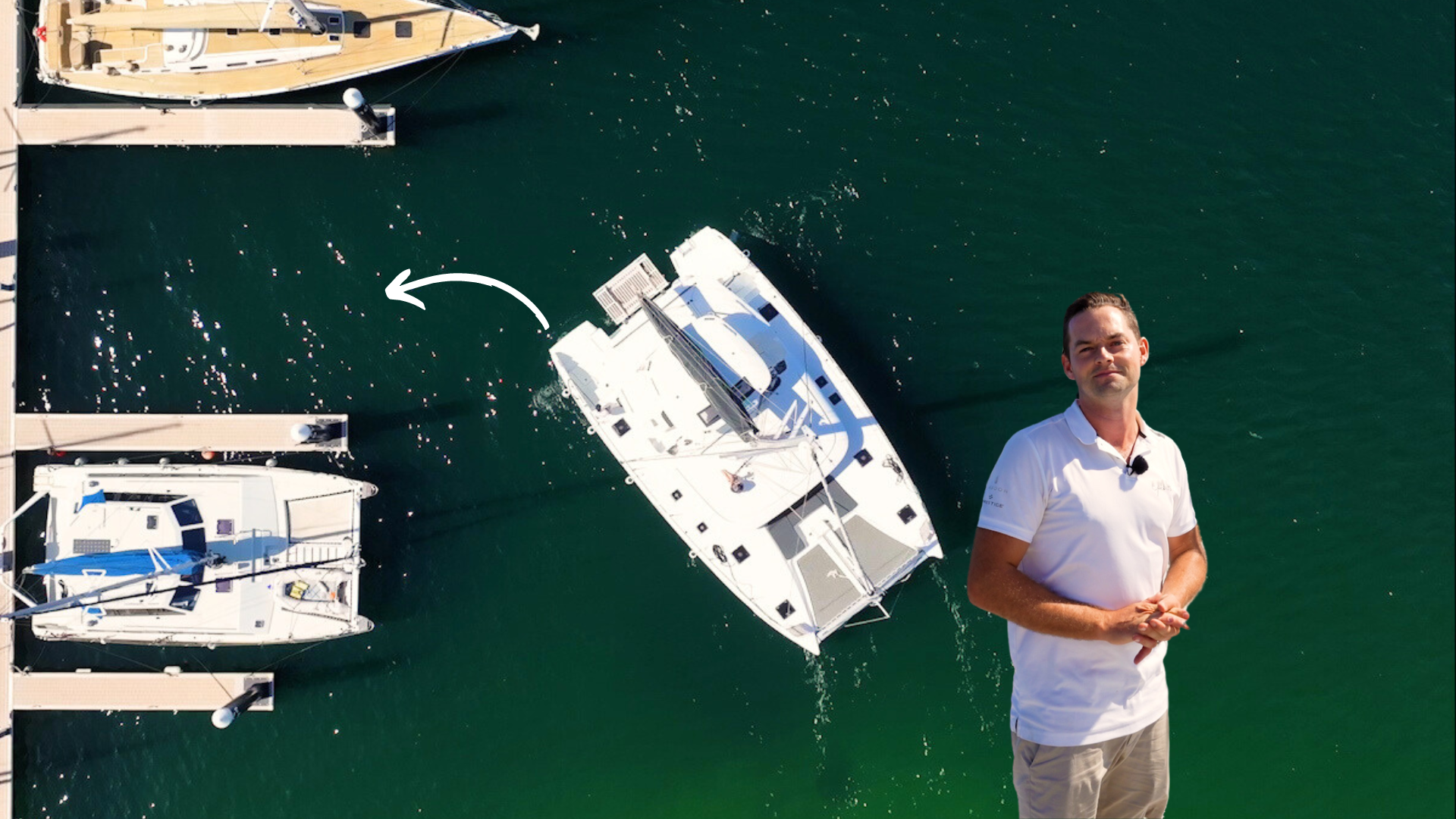
How to Dock in a Crosswind on a Catamaran (in a tight space)
by Giorgia Gargiulo
In this episode, join Joe Fox as he walks you through the intricate process of docking a catamaran in a tight berth with a crosswind.
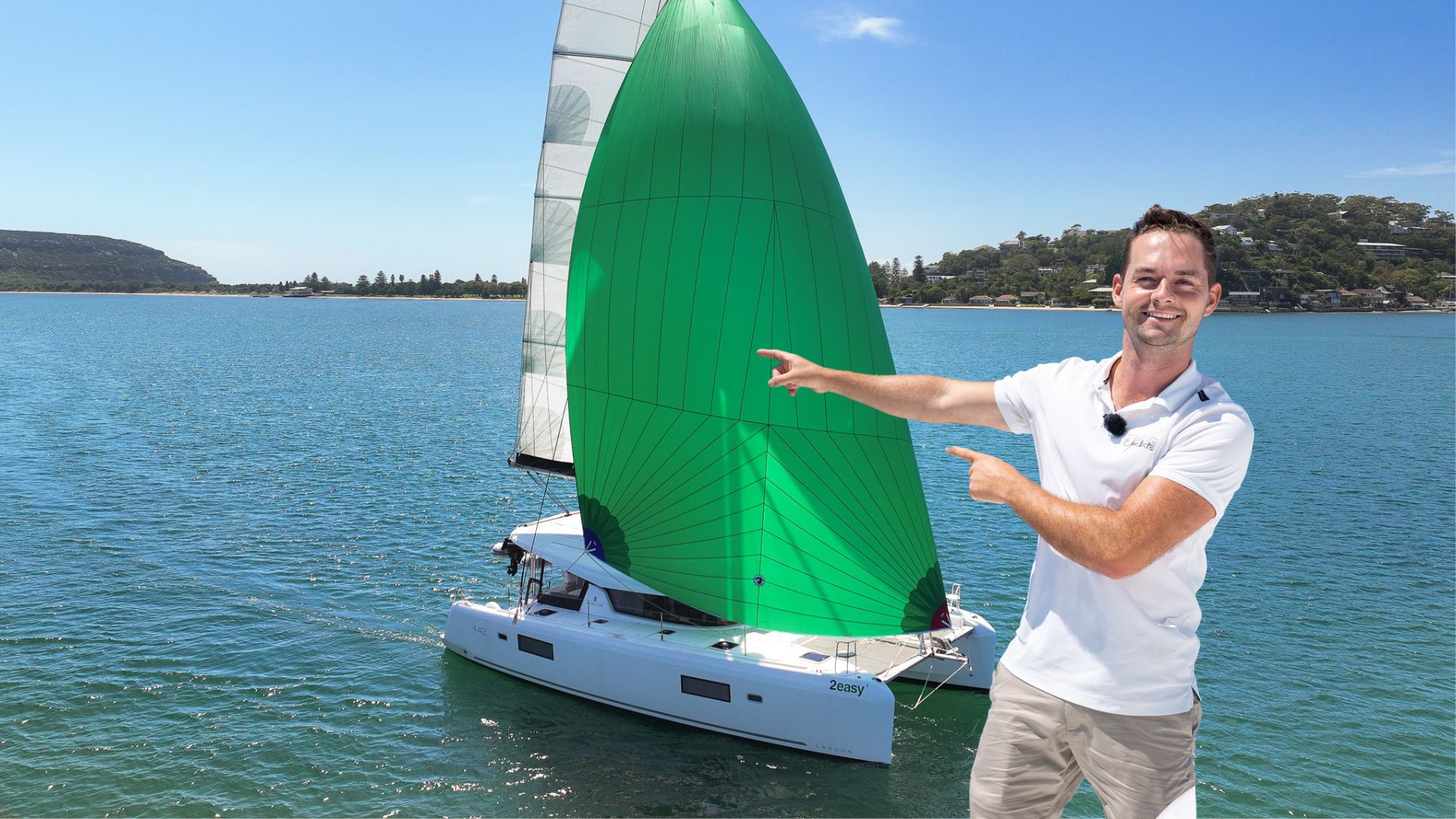
How to Fly an Asymmetric Spinnaker on a Catamaran
by Marnie Ebeling
In this guide, we delve into the intricacies of flying a Code Zero on a catamaran, specifically the Lagoon 46. Join our expert, Joe Fox, as he walks you through the setup, preparation, and manoeuvres involved in harnessing the power of this versatile sail.
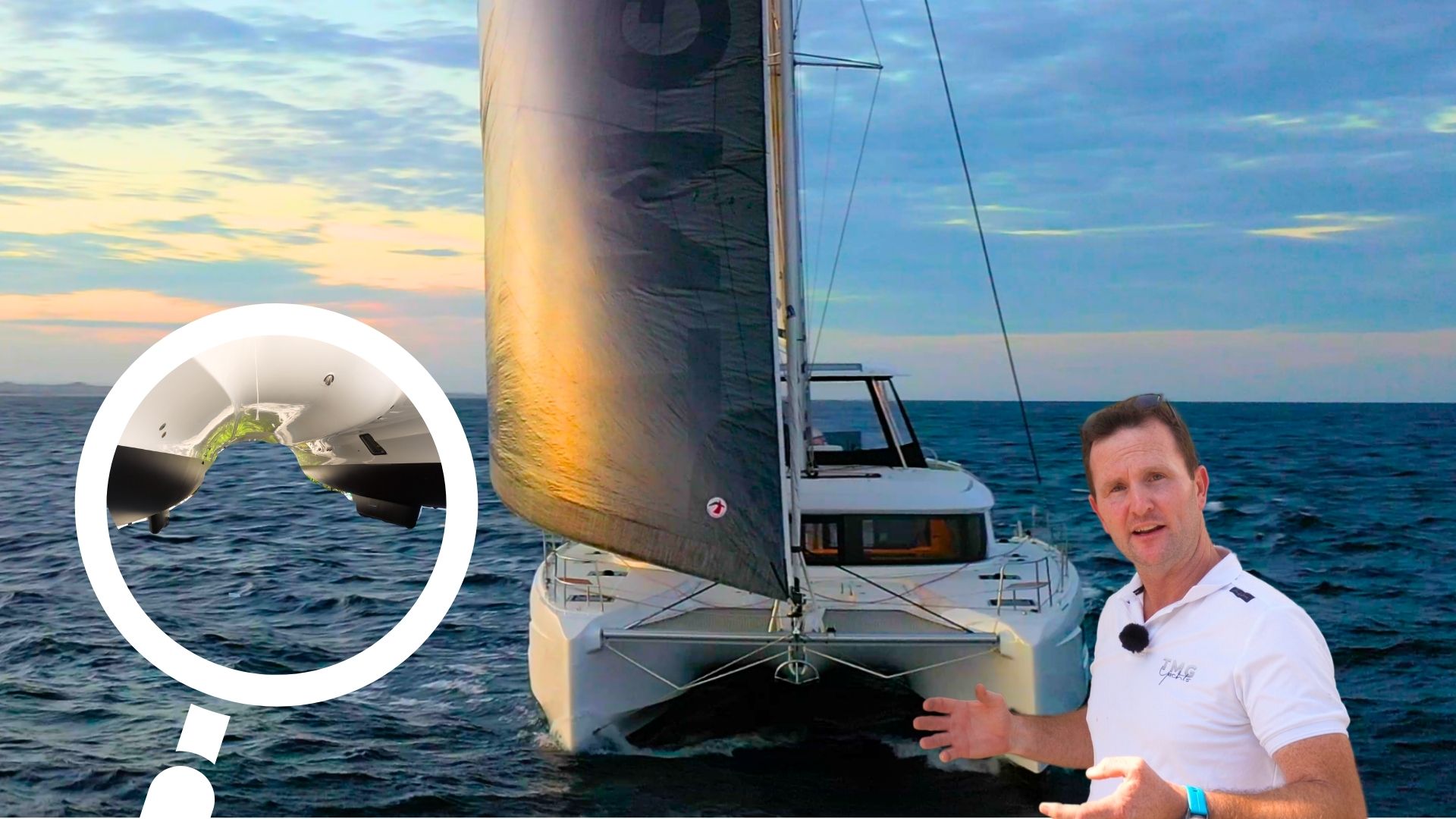
Guide to Hull Maintenance & A Detailed Look Below the Surface
In this instructional piece, we delve beneath the waves to explore the underwater profile of the a Lagoon Catamaran. Join us as we dissect the key features and maintenance points of the Lagoon 46, offering insights into what to look for during routine upkeep.
The Worldwide Leader in Sailmaking
- Sail Care & Repair
- Sailing Gear
- Find A Loft
- Sail Finder
- Custom Sails
- One Design Sails
- Flying Sails
- New Sail Quote
- 3Di Technology
- Helix Technology
- Sail Design
- AEROTECH Spinnaker Cloth
- NPL RENEW Sustainable Sailcloth
- Sailcloth & Material Guide
- Polo Shirts
- Sweaters & Cardigans
- Sweatshirts & Hoodies
- Accessories
- Shop the look
- Mid & Baselayers
- Deckwear & Footwear
- Luggage & Accessories
- Fall Winter '24
- North Sails x 37th America's Cup
- Sailor Jackets
- SALT X North Sails
- NS x Slowear
- T-shirts & Tops
- Sailor Jacket
- Sustainability
- North Sails Blog
- Sail Like A Girl
- 37th America's Cup
- Icon Sailor Jacket
- Our Locations
- Certified B Corporation
- North SUP Boards
- North Foils
- North Kiteboarding
- North Windsurfing
SAIL FINDER
SAILING GEAR
COLLECTIONS & COLLAB
COLLECTIONS
WE ARE NORTH SAILS
ACTION SPORTS
Popular Search Terms
Organic cotton
Scuba fleece
Drawstring hood
Utility pocket
Stand collar
Sorry, no results for ""
Subscription
Welcome aboard.
We want to make our emails as relevant as possible for you.
Interests saved
Something went wrong, please try again
Welcome to North Sails
Stay up to date with the latest North Sails news.
Receive a 10% discount code for your first apparel order. Excludes sails and SUP’s. See our Terms and Conditions .
Yes, I agree to the terms of use and privacy policy.
THE LATEST OBSESSION: CODE ZEROS
A win-win decision.

GET IN TOUCH
REQUEST A QUOTE
BROWSE ALL SAILS
FIND YOUR SAIL
Latest north sails news.
16 September
TRAVEL JOURNAL: AT HOME IN TARIFA
07 September
AEROTECH: A REVOLUTIONARY HIGH-PERFORMANCE WOVEN DOWNWIND SAILCLOTH
06 September
BIGGER BOATS BUT THE SAME SKILLS
- Refresh page
Home > Education & Expertise > Downwind and Light Wind Sails > Code Zero
Code Zero Sail
The Code Zero is a spinnaker-genoa hybrid. It’s designed to operate like a genoa but considered a spinnaker under racing rules (depending on its dimensions). This cruiser’s dream sail helps a boat’s performance in close reaching angles, especially in lighter winds, by generating much more speed than a slightly eased head sail. These sails also reach very well in moderate wind. A low stretch Vectran/Dyneema line or a torsion cable is normally used for the luff, and the sail is tensioned firmly to get a straight luff (a lot like a genoa).
A Code Zero has a mid girth of 75% of the foot length, so it measures as a spinnaker but has a much bigger area than a genoa. The optimal wind speed for this sail is 3 to 18 knots true wind speed and in lighter winds, you can carry this sail up to a 45-degree true wind angle. Typically they are designed to be flatter than a spinnaker and have a straight leech exit.
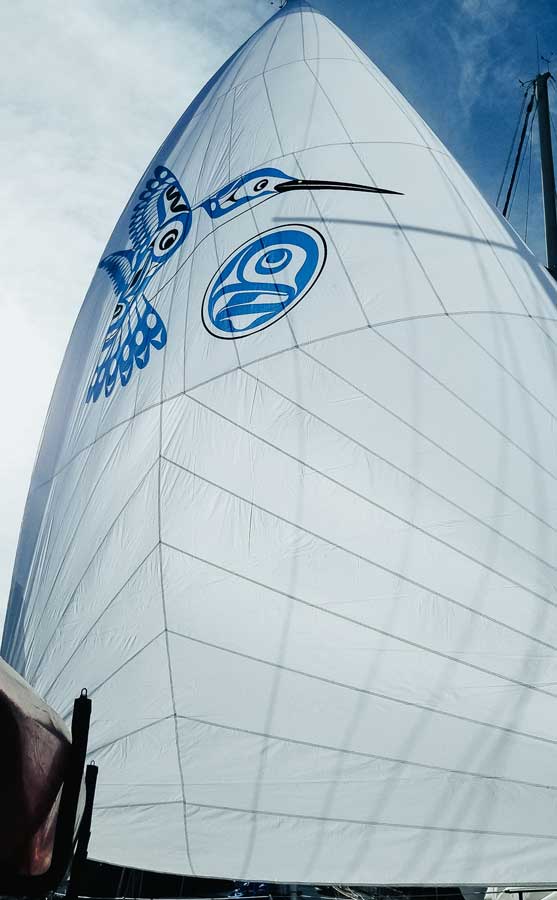
High-quality Code Zeros that’ll stand the test of time, no matter what you’re up to.
What makes a code zero.
The Code-Zero should be recognized as a spinnaker in the racing community, which means it must have a Mid Girth (MGM) no less than 75% of the Spinnaker Foot Length (SF).
The Code-Zero should have a solid luff, unlike drifters or Asymmetric Spinnakers which are free-run, attached only at the head, tack, and clew. The Code-Zero is run off of a dyneema or torsion line that keeps the luff straight and more rigid allowing it to point higher than an asymmetrical spinnaker but has a Leech Curve (as opposed to a hollow) increasing Sail Area and allowing the sail to power properly in low winds.
The torsion line is either built directly into the luff of the sail, or will use a system such as a zipper luff which allows the torsion line to be installed and removed easily. Often furling systems such as Harken Reflex, or Profurl SPINEX, come with a specialized torsion line.
Construction
Code Zeros can be made out of either Spinnaker Nylon, a lightweight Dacron, or a Code Zero lightweight laminate (such as Contender ZL series). As Code-Zeros are run at varying degrees and can function at a reach it is easy for sailors to push the limits of the intended speeds and angles causing damage to the sail. It’s important to know if you are going to need a sail that is more durable, lighter weight, or more performance driven – each of which has advantages and disadvantages. As a baseline, Precision Sail’s code zeros are designed with a zipper luff to allow a torsion line to be added/removed for storage and cleaning.
Heavier woven cloths, such as a 4oz Dacron, will provide durability and if you’re leaving the sail up for weeks at a time, Spinnaker Nylon is very lightweight 1.5 – 2oz, and will allow you to sail in very light winds. Finally, laminates are very performance orientated, with low stretch and very consistent sail shape; there’s also so much armamid in the Code-Zero laminate cloths that it’ll push your boat over before causing damage to the cloth, making it great for offshore sailing. A Code Zero Laminate will provide both lightweight performance in light air, and durability while crossing the pacific for an offshore catamaran cruiser with a displacement of 15,000 KG.
Catamaran Code-Zero
Many catamaran cruisers love to run a Code-Zero, just listen to Sailing Nahoa who rave about theirs! While there are many advantages, it’s important to note that you’re going to be restricted by the rigging for how the sail is going to be able to point. If the wide shrouds don’t allow you to sheet the sail in tight, you may not be able to hit 45° that many people expect out of the Code Zero.
Sailing Resources
Read more about Spinnakers and Code Zeros to help ensure you know what you want to know!
All About Spinnakers
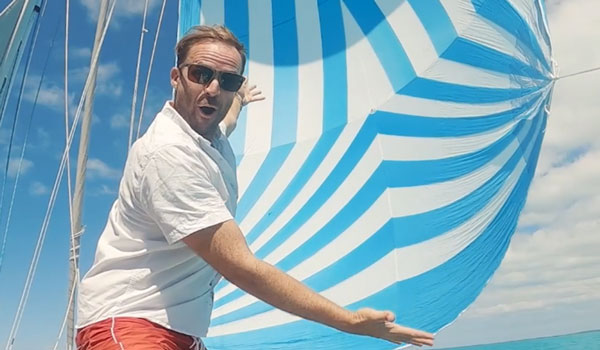
Sailing With a Spinnaker – Asymmetrical Basics (Gennakers and Light Air Sails)
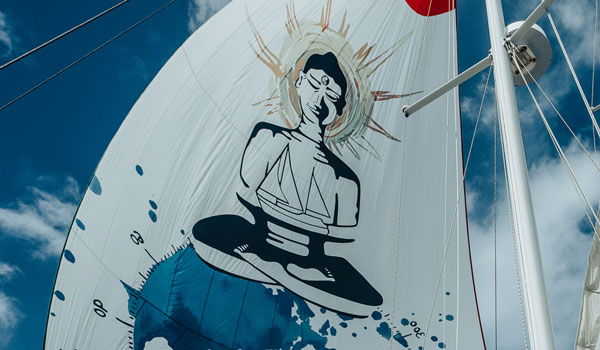
Sail Graphics, Colored Dacron and Color Customizations
Still confused.
Speak with a sail consultant and dial in your requirements for the perfect code zero.
" * " indicates required fields
Thanks for telling us a bit about yourself and your boat. Our team will send you a preliminary quote based on information we have gathered from sailors similar to you.
We will give you a call in order to narrow down the options on your quote and improve the accuracy. If you want us to call you at a specific time, feel free to schedule a time on our calendar!
Thanks for telling us a bit about yourself and your boat. Our team will reach out to offer some suggestions and get started on finding you the perfect sail!
BoatNews.com
Code 0, the light and powerful sail for sailing close to the wind
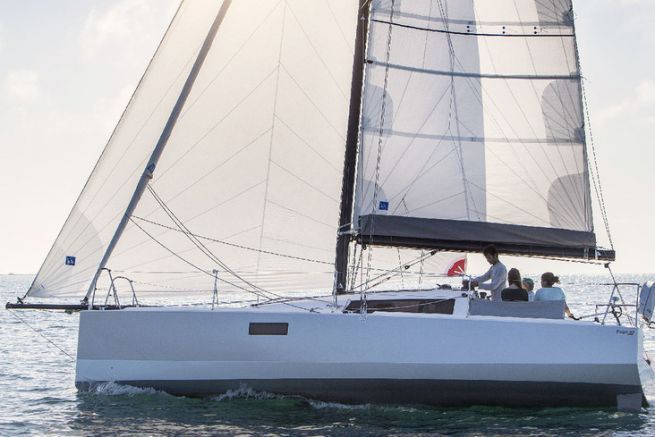
While summer and high pressure are installed on your navigation basin, you dream of a few extra knots to move your sailboat. Code Zero then becomes your best friend with its few extra square meters to get you moving.
Where does this Code 0? come from?
It seems that this terminology was coined during the 1998-99 Whitbread to define a flying canopy to be used upwind. There were already Codes 1, 2, 3... for sailing from full throttle to close hauled. The term Code 0 was coined to define a sail capable of sailing at tighter angles than any other flying sail . Over the last two decades, the evolution of materials and designs has made it possible to create very specialized sails for light airs.
A large, light, free edged genoa
The Code 0 is a kind of large, very light genoa that can be sent in the manner of an asymmetrical spinnaker or as a gennaker. This sail allows to tighten the wind in very light winds. With blocked materials such as laminated fibres and a fairly flat design you will almost be able to sail upwind. On the other hand, a slightly flexible fabric and a hollow shape will not allow you to sail upwind beyond 80°.
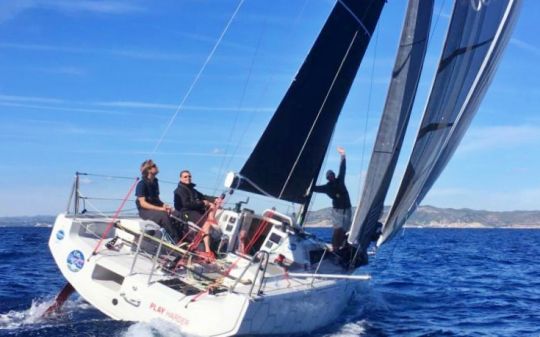
Who is the Code 0? for?
When the calm settles in, this sail is particularly useful on racing boats without a motor. However, it is gradually gaining ground on cruising yachts , which sometimes suffer from overweight and low overlapping headsails. Code 0 with furlers is becoming a relevant solution for increasing sail area in light airs.
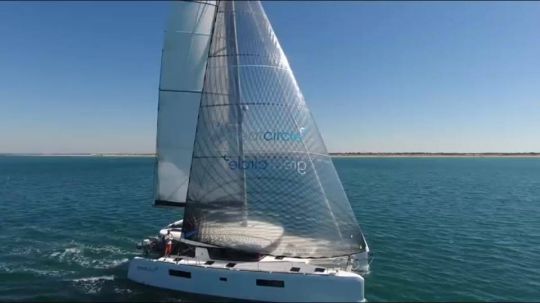
In regattas, can we use the 0? Code?
If you are a handicapped regatta sailor (IRC ORC...), you will be tempted to take such a sail on board. However, be careful with the measurements, otherwise your sail could be considered as a genoa, which would significantly increase the handicap of the boat . In IRC, the sail must be at least 75% of the edge at 50% of its height, in other words the shape is closer to an asymmetric spinnaker than to a genoa.
Can we turn around with a Code 0??
Tacking is not really the strong point of this sail , which will be more willing to gybe. However, if you wish to tack with Code 0, you will have to furl it in a large part before changing tack.
What are the criteria of qualité??
To be effective, the fabric should be "blocked" as much as possible with laminated materials. A nylon sail , such as a spinnaker , will only have a small range of use. In fact, when tacking to get closer to the wind, the leech will recede until it closes, which will then dump its wind into the mainsail ... all this is not very effective.
If you are using a furling system, the quality of the anti-twist luff rope is essential to roll the sail in all circumstances. The price of the rope is often directly related to its anti-twist properties. Some manufacturers such as All Purpose have developed Codes 0 that integrate the anti-torsion effect into their structure. This solution has already been validated on many racing boats and could soon win the pleasure boating market.

Can we keep the Code 0 in the mail and enroulé??
A Code 0 wrapped around its cable is a sail that will be quickly unfurled or stowed away. This equipment is not designed to stay in place full time. Although it is possible to keep it rigged for a few moments, it should be lowered as soon as the wind conditions cool down.

- BUY A SAIL NOW
- WARRANTY POLICY
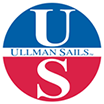
THE LANDING: BLOG
Cruising the code zero.
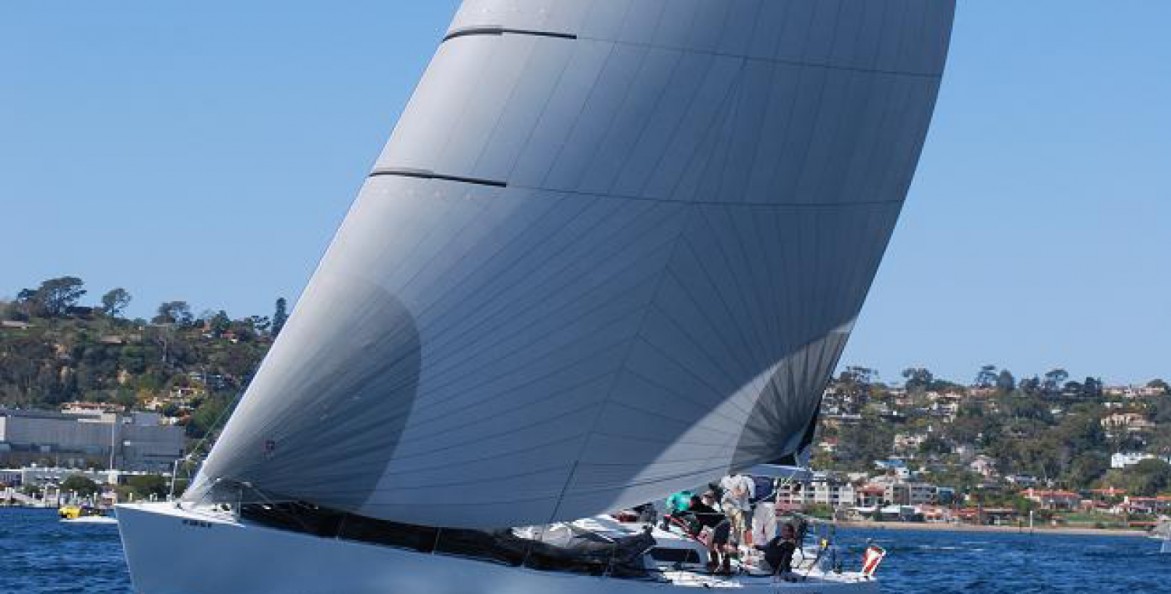
Chuck Skewes of Ullman Sails San Diego
By Chuck Skewes of Ullman Sails San Diego
Many sailors, especially cruisers, shy away from cruising the code zero, despite the sail’s versatility and ability to add significant increases in boat speed. In this article we remove some of the mystique around this specialty sail and explain how it can be used to enhance anyone’s sailing experience.
What exactly is a code zero?
Officially a code zero is a spinnaker for use in tight-reaching in light air – that’s it! The sail tends to be the smallest spinnaker in any sail inventory, whether racing or cruising. Racers have discovered that because of its size and applicable wind strength and angle ranges, the sail has benefits for racing performance while avoiding rating penalties. However, the practical applications of the sail apply just as much (if not more) to cruising boats.
The code zero was introduced in the 1997/98 Whitbread (now Volvo) Round the World Race. The event winners, Paul Cayard and the crew of ‘EF Language’, used a very small, tight-reaching spinnaker that could be used while the other teams could only use their genoas. It was very successful and since its introduction racers around the world have followed suit. The sail is considered a spinnaker instead of a genoa because of its dimensions. Sails built with a mid-girth length (the shortest distance between the leech mid-point and the luff) greater than or equal to 75% of the foot length qualify as spinnakers. The code zero meets this requirement. The mid-girth measurement is used in the rules to prevent teams from making 180% genoas and calling them spinnakers without the sail impacting their rating.
How does the sail cross-over for cruising?
Since cruising sails don’t have to meet any racing requirements we can actually make a much better sail for cruisers. The sail works like a very light, very large genoa. With a cruising code zero we can make the leech much straighter vertically, which allows us to make a straighter exit for the wind. This reduces heel and makes the sail more efficient and versatile. Essentially it provides more horsepower in light air, making sailing much more enjoyable. It is ideal for modern boats that have small non-overlapping headsails.
If someone occasionally races in beer-can races, can they use the cruising code zero to race?
A cruising code zero will rate as a genoa, so if it is larger than your largest genoa (and they always are!) you have to report it or not use it.
What wind ranges and wind angles do you use a cruising code zero in?
You can typically use a cruising code zero from 70° true wind angle (TWA) in very light air up to 110° TWA in 15+knts. Ultimately it depends on the righting moment of your boat and how comfortable you are with how much the sail may make your boat heel in significant breeze or at tighter angles. Most cruising code zeros are designed primarily for use in 85°-100°TWA.
How much extra performance should I expect to get out of a cruising code zero?
In light air the added speed generated from the sail is significant. It often more than doubles your sail area and can increase performance up to 30% as compared to a non-overlapping genoa.
If a code zero is for light wind, does that mean I’ll be motoring less? Do you use it for offshore cruising? Or would I use it in a harbor as well?
We use the code zero anytime the wind angle and wind strength are correct, whether we are in the harbor or on a long cruise. The light air performance will allow you to sail more and motor less, which, at least among our customers, we’ve found is typically the goal.
Are code zeros furling sails? Are they easy to launch? How many people do you need to do that?
Ullman Sails can design a code zero either as a furling sail or to launch from a sail bag. I recommend furling because you can set it up at the dock and easily roll and unroll the sail as the wind velocity and your angle change. Also, if you furl the sail, it can be used while single-handing. If you bag launch the sail you will want 3 or more crew on deck.
Have you had experience cruising with a code zero? Do you have a question we didn’t answer? What impact did it have on your sailing experience? Any advice you can offer to other sailors considering adding the sail to their inventory?
About Chuck Skewes A Seattle, Washington native, Chuck is an avid pro sailor and sailmaker. In just the last year Chuck has been part of the winning crews in the International Masters, Beneteau 36.7 West Coast Championships, and the Tjorn Runt in Sweden. He is also the loft manager at Ullman Sails San Diego and Ullman Sails Pacific Northwest. Chuck currently resides in San Diego and has been sailmaking since 1984.
- BOAT OF THE YEAR
- Newsletters
- Sailboat Reviews
- Boating Safety
- Sails and Rigging
- Maintenance
- Sailing Totem
- Sailor & Galley
- Living Aboard
- Destinations
- Gear & Electronics
- Charter Resources
- Ultimate Boating Giveaway

8 Common Misconceptions about Code Zeros
- By Quantum Sails
- Updated: June 30, 2016
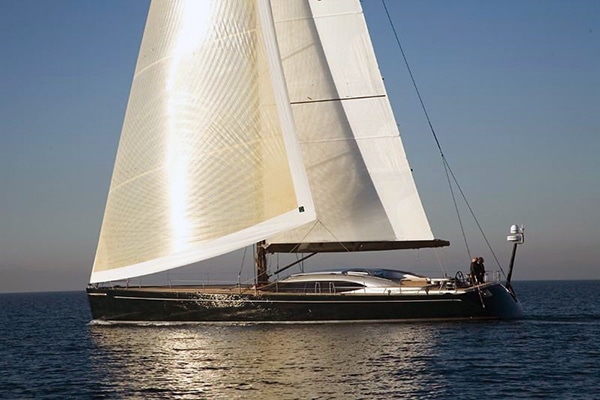
The Code 0 has only really been around for 20 years, born in the Volvo Ocean Race, back when it was still called the Whitbread Around the World Race. They have characteristics of being an upwind sail, but are classified as a downwind sail. Some are built out of nylon, while others use a heavier, plastic-like material. Not knowing really what to call them, they are often referred to as a “Gennaker.” The result is, there are a lot of things we think we know about a Code 0, many of which aren’t true, or at least, not always.
1. A Code 0 is another name for a Gennaker.
Not necessarily. The term Gennaker can cover a Code 0, Screecher, or a reaching spinnaker. Gennaker is just a general term for a potential downwind sail.
2. A Screecher and a Code 0 are the same thing.
Nope. A Screecher is specifically a multihull term for a very large, very flat sail, for going upwind or just cracked off. Catamarans and trimarans have notoriously small jibs making them grossly underpowered in light breeze. A Screecher is larger, higher clewed, and fuller than a Genoa, but much flatter than a Code 0.
3. A Code 0 is strictly a racing sail.
Cruisers of all ilks have taken to the sail for its range and ease of use. True downwind spinnakers can be unruly and intimidating for a shorthanded or novice crew, but the range and furling ability of the Code 0 make it a fantastic sail for a weekend outing. We find that once introduced to the Code 0, cruisers will use this sail more than any other on the boat.
4. All Code 0s are created equal.
A Code 0 is a Code 0 is a Code 0, right? Not true. While the Code 0 for racing monohulls is restricted to a midgirth of at least 75% of the foot length and a leech that is no more than 95% of luff length, Code 0s for cruising boats and multihulls can be significantly larger and have a lot more variety in their design, from very deep to very flat. Quantum’s racing Code 0s and some cruising Code 0s are made with Dimension-Polyant CZ GP fabric, a stiff, plastic-like material, while Code 0s for multihulls are made with heavy nylon.
The most important question to ask yourself as a boat owner is, “What do I want to do with this sail?” Are you a racer or a cruiser? Do you want to use it to sail in very light air to sail relatively close to the wind, or will you use it on a broader reach? The answers to those questions will help your sailmaker determine the design of the sail that’s right for you.
5. A Code 0 is strictly a downwind sail.
A Code 0 is classified as a spinnaker in terms of racing, hence the restriction on the length of the midgirth, but it’s not a true downwind sail. If you’re going downwind, you’ll use either a symmetrical or asymmetrical spinnaker. While it does depend on the wind speed, especially for boats without a 155% genoa, there’s a lot of range between the jib and the first true spinnaker. As soon as you crack off even 5° from the range of the jib, you could be into Code 0 territory.
In very light air, up to eight knots, a Code 0 designed with a longer leech and lower clew can be sheeted inboard and used at a higher angle. A higher clew with the sail sheeted to the back of the boat is a reaching Code 0, and can be used in slightly higher breeze. In an ideal world, we’d sell every boat two Code 0s: One for upwind and one for reaching, but we know most boats can only carry one. Whether you’re a racer or a cruiser, it comes back to that question from the sailmaker—what do you want to do with this sail?
6. A Code 0 is a beast to get down.
Okay, so the early Code 0s did require an experienced crew to get them back onto the deck safely and cleanly. But today, the majority of Code 0s are designed on a top-down furler, making it possible for even a novice crew to go from the jib to the Code 0 in a matter of seconds. And while some more experienced crews may still forgo the top-down furler as a weight consideration, most boat owners find that the slight increase in weight on the bow offers them the ability to seamlessly change modes on a tenth of a knot, often for huge gains in light wind conditions.
7. A Code 0 is really expensive.
Early top-down furling systems required a custom-made torsional rope. Really good systems with a quality torsional rope were sometimes as expensive as the sail. However, with more and more manufacturers offering top-down furling systems and torsional rope now available pre-made on a drum (at least for mid-size boats), the overall cost of the sail and the system has come down significantly.
8. A Code 0 can do anything.
We just said that the Code 0 is appropriate over a huge range especially in light wind conditions, and being situated on a top-down furler makes it hugely convenient, even for novice sailors, however a Code 0 cannot in fact, “do anything.” We see Code 0s fail most often when they’re pushed too high in too high of breeze—this is a particular problem on multihulls because the boats are so stable. A Code 0 also can’t live indefinitely tacked to the bow of your boat. While cruising Code 0s will have a thin strip of UV protective material, if left indefinitely in the sun they are sure to shrivel up into a brittle, moldy end.
In racing, to maximize a Code 0, it’s important to know your crossovers. Be diligent about going out and recording wind speed and wind angle as you switch between your jib, Code 0 and spinnaker, and then stick to those numbers.
So there you have it. A Code 0 will take you through more wind angles than any other headsail on your boat. Add a modern top-down furler and it’s easier to get up and down than a spinnaker. Racing in light, shifty conditions, it might just be the sail that helps you eek out precious tenths, which turn into minutes or even hours on a long distance race. And they’re a whole lot less expensive than they used to be. The last question is, what are you waiting for?
This cruising tip is courtesy of Quantum Sails.
- More: How To , quantum cruising tips , sails , sails and rigging
- More How To

Grease the Wheels of Your Boat: A Guide to Proper Lubrication

A Bowsprit Reborn: A DIY Renovation Story

Rigging Redo: Our Switch to Synthetic

Top Tools for Sailboat Cruising: Must-Have Gear for 2024

Galápagos: A Paradise Worth the Paperwork

Around Alone

- Digital Edition
- Customer Service
- Privacy Policy
- Terms of Use
- Email Newsletters
- Cruising World
- Sailing World
- Salt Water Sportsman
- Sport Fishing
- Wakeboarding
Quantum Cruising Code 0: For All the Angles In Between
January 28, 2016
With no restrictions on design, the Quantum cruising Code 0 is created to be a very forgiving sail, perfect for light air on close angles upwind, at very broad angles in heavier breeze, and all the angles in between.
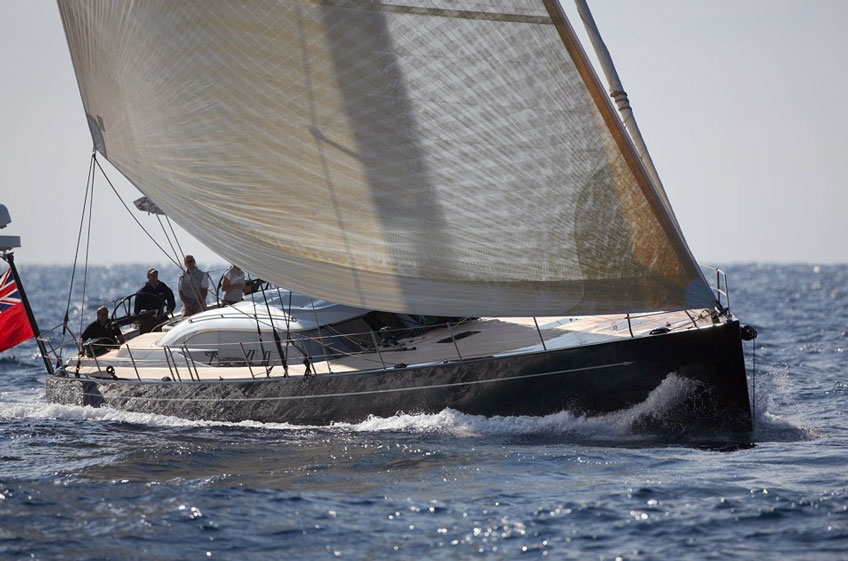
The Quantum Code 0 for cruising monohull sailboats is a full sail, shaped like an asymmetrical spinnaker, and furls easily on a top-down furling system. While the midgirth of the racing Code 0 is restricted to at least 75% of the foot length, the cruising version of the sail has no restrictions, giving the sailmaker a lot of leeway in design.
“You can make the midgirth anywhere from 55% to 75% of the foot length, allowing you to make them very deep and very flat,” says Quantum’s VP of Product Integration and sail designer Doug Stewart.
Many cruisers are intimidated by downwind sails, especially when sailing shorthanded or with inexperienced guests. The Code 0 is perfect for cruising boats because it is easily deployed on its furler and has a UV strip to protect it during a whole weekend or several days of use so that it doesn’t have to be taken down. “We find people will use this headsail more than any other on their boat,” says Stewart.
How And When To Use The Code 0
The sail can be used at relatively tight angles in light air, and at very broad angles in heavier air. “It will take you through more wind angles than any other sail on the boat. Your kite is for downwind, your genoa is for upwind; the Code 0 is for all the angles in between,” Stewart says.
Rob Greven of the Netherlands-based Spirit Yachting first added a Code 0 to his sail inventory in 2009. “I was looking for a sail within my budget, easy in handling, good performance and reliable, and covering most of the wind angles.”
Now he says, he uses the sail on his Beneteau Oceanis 46 Spirit with clients and with his crew, on everything from short day trips to long-distance singlehanded racing—even the Rolex Fastnet race.
“We don’t carry a big genoa, so we use the Code 0 in light winds upwind—depending on the wind, up to around 40 degrees AWA. In the wind range of seven to eight knots, it’s possible to make seven to eight knots of boat speed. Even with our cruiser, it offers excellent performance.”
Greven says the versatility of the sail even extends to downwind running in stronger breeze between 18 to 24 knots at an angle of 160 to 170 degrees. “I’m able to sail light on the helm and with good control.”
He also carries a Quantum Vision Code 3 for downwind sailing with a full crew, but says the Code 0 is easier to use when sailing short- or singlehanded. “Since the sail is a little smaller and flatter than the V3, it’s a perfect sail for shorthanded sailing, even in stronger winds. It is better on the helm and easier to furl away,” says Greven.
Taking Care Of The Sail
While the cruising Code 0 is designed with a protective UV cover, that cover is still very light. It will easily survive several days of use, but if you won’t be on the boat for a week or more, take the sail down, put it in its bag, and store it down below. Also, as with any sail furled on a torsional rope, if a storm blows through, there’s nothing to stop the sail from opening up. So if inclement weather is approaching, get the sail off the deck.
The Sail Sells Itself
Greven would be the first to recommend the Code 0 to other cruisers, but says the sail sells itself.
“Last autumn, I sailed a singlehanded regatta, several days from one place to another. I almost only used the Code 0 in light winds and got a lot of positive response from other sailors.”
So while choosing a new sail for your inventory depends largely on what kind of sailing you want to optimize for, be sure to check out the Code 0. The versatility of the sail, combined with ease of use may very well prove to be the next best sail on your list.
Top Eight Misconceptions About Code 0 Sails
The Quantum Sails Racing Code 0: Take Your Program To The Next Level
The Discussion
“You can make the midgirth anywhere from 55% to 75% of the foot length, allowing you to make them very deep and very flat,” says Quantum’s VP of Product Integration and sail designer Doug Stewart. Do you an article that explains this? I'm preparing my boat for some extended voyaging and have never been happy with light air performance. I want to understand it better so I know what to ask for. PS my spinnaker gets over powered at 18kts so I'm digging the 18 to 24 aspect you talked about!
Bob, Give us a target range of wind angles and velocities you want to cover, let us know what you have already and what range they work in, and tell us a little about the type of sailing you are doing and your goals and we can craft the perfect addition to your downwind inventory. For reference, check out… https://www.quantumsails.com/Resources-and-Expertise/Articles/Top-8-Misconceptions-About-Code-0-Sails David Flynn ([email protected])
This website uses cookies and collects usage statistics. Privacy Policy
Us, too. We pour that passion into each of our newsletters to help you enjoy sailing even more.
- andrewmorrisey
- Apr 4, 2021
What type of Asymmetrical Spinnaker? Code Zero vs Code D.
Decisions – Decisions --- Code Zero or Code D?
What will be a better down-wind sail for our new Elba45 for our initial adventure coming down the coast of France-Spain-Portugal on the Atlantic side and then cruising in Mediterranean Sea next summer (2022)? What would be a better Asymmetrical Spinnaker, the Code Zero or Code D?
Both kites are on a roller furler which makes it much easier to douse, especially when a squall comes out of no-where. I do not think we will need a full Symmetrical Spinnaker until we do the Atlantic crossing. Looking forward to your comments and opinions on this one.
The Code Zero
The Code Zero is a cross between a genoa and an asymmetrical spinnaker that is used for sailing close to the wind in light air. Code Zero was initially an attempt to circumvent a rating rule by making a large genoa for close reaching on boats that were measured with non-overlapping genoas. The Code Zero got around the rule by measuring in as a very narrow-flat spinnaker with shape similar to a reaching genoa. Cruising sailors have a lot more options on the size and shape of a "code" sail.
The code zero is very flat and is designed for close reaching. It has a nearly straight luff, a mid girth about 60-65% of the sail's foot length. This sail is closer in shape to a traditional drifter than a spinnaker.

Cruising Code Zero (left) and a Cruising Spinnaker (right). The Code Zero is a much flatter "triangular" shaped sail that is designed for close reaching. The Cruising Spinnaker is bigger and rounder and designed for broad reaching.
The Code zero runs wind angles from 50-110 degrees.
The Code D is a cruising spinnaker with a nearly straight luff that furls from the bottom up, just like a genoa. ... Most Sailmakers has succeeded in developing an asymmetrical spinnaker that performs well from 80-degrees apparent wind angle to nearly dead downwind. With a regular, continuous line furler, it’s easier to use than a Stasher system and less expensive than top-down furlers. The Code D gets its name because its shape, a straight luff and round leech, makes it look like the letter "D."
It’s polar range is wide and can sail from 60 degrees to 140 degrees. If you have a spinnaker pole on the down-wind clew it can be pushed out to accommodate full dead down-wind angles of 180 degrees.

The comparison
-Upwind to apparent wind of 50 degrees
-Reaching to apparent wind of 110
-Apparent wind speed: 1-16 knots
-Approximately 60% of the sail area of a full-size spinnaker and about twice the size of a non-overlapping genoa.
-Upwind to apparent wind of 60 degrees
-Reaching to apparent wind of 140 degrees
-Apparent wind speeds: 1-16 knots
- Approximately 70% of the sail area of a full-size symmetrical spinnaker

After reviewing all the details we have decided to order a Code D and will let you know next year what we think. Note that on our J30 in Canada we have a APR 70 Asymmetrical Spinnaker in addition to a full Symmetrical spinnaker.

Recent Posts
It is now official - our new boat has been registered and licensed with the name 45North.
A taste of the cruising life in our own back yard
What to do when you have a floating home in the Mediterranean Sea? sv Makin Waves to-do list.
- AROUND THE SAILING WORLD
- BOAT OF THE YEAR
- Email Newsletters
- America’s Cup
- St. Petersburg
- Caribbean Championship
- Boating Safety
- Ultimate Boating Giveaway

Code Zero Sails Help Build a Better Offshore Inventory
- By Jeff Thorpe and Rob MacMillan
- Updated: May 8, 2012
It’s one of those perfect offshore nights: solid wind, easy swell, clear sky, and sheets eased on a headsail reach. The on-watch crew is active on the sail trim and you’re making gains on your competitor to leeward. Fast-forward three hours into the watch. The navigator sticks his head up the companionway and asks, “What happened to the boat that was next to us?”
“Well, the breeze continued to build and went aft a bit,” you respond. “They were able to continue sailing their course, but we were struggling with speed and had to head up to maintain pace with this headsail.”
“Why is he able to sail that angle but we cannot,” counters the navigator. “We’ve been working him all night.”
“We think they did a sail change, maybe a kite,” is your answer. “With the increased breeze, we can’t carry our spinnaker at that angle. It’s too risky.”
“Damn. I wish we’d brought a reaching kite instead of only runners,” the navigator sullenly mumbles.
If a similar conversation has ever occurred on your boat, you’re not alone. Building the ideal sail inventory for a particular distance race is one of the most important aspects of your race preparation. The best way to ensure you have the right sail for the right conditions is to recognize any gaps in your inventory, gaps that, once filled, allow you to sail the best angle possible at all times.
The first step is to take a good look at your existing sail inventory , and then define the designed true windspeed and true-wind angles of these sails. Divide your inventory into three parts: upwind, downwind, and reaching. You probably have one main, three or four headsails that cover you in light, medium, and heavy conditions, and likewise for your downwind sails. It’s the reaching sails that are more difficult to fit into the inventory. You’ve got jib tops, reachers, Code Zero sails, and staysails as options, and it’s here in the reaching sails where you’ll most likely have the biggest gaps.
To give some insight into building a more versatile inventory, let’s explore a few commonly asked questions.

Courtesy of Quantum Sail Design
I need to improve my reaching inventory, but I am confused by the terminology and coding of some of the sails. Most sailmakers refer to odd numbered sails (A1, A3, A5) as reaching spinnakers and even numbered sails (A2, A4, A6) as downwind-orientated sails. Code Zero sails are most effective between 80 to 125 degrees true-wind angle, in windspeeds of 5 to 18 knots. However, it’s important to remember that the Code Zero is measured as a spinnaker. You can push these sails to slightly tighter angles in light winds, but be prepared for leech flapping. An A7 is a very small sail for very big breeze, 28 knots or more. It’s typically a fractional sail. A jib top is a high-clewed headsail used for tight beam reaching.
My boat came with a typical upwind sail inventory, but my crew insists we could use a Code Zero, especially if the race turns into an upwind drifter; is this true? A common misconception is that a Code Zero can be used upwind in place of a genoa. In perfect conditions—light-wind, smooth water—a true-wind angle of 70 to 80 degrees is about as close to the wind as you’re going to get from a Code Zero. On a masthead-rigged boat with 155-percent overlapping genoas, the gap that exists between a large jib top and an A5 reaching spinnaker is not significant enough to warrant a Code Zero. On a fractional-rig boat with non-overlapping jibs, however, a Code Zero is a necessary sail because of the significant gap between the smaller non-overlapping jib and the A5 reaching spinnaker.
For a long downwind race where I may need the same sail for extended periods, how do I make sure I have redundancy in the sweet spot of my asymmetric inventory? For Transpac, and many other coastal and offshore races, the A2 spinnaker is your workhorse. But the A2 you use for inshore buoy races to sail at low angles may not be the best sail for offshore racing, when surfing waves and dealing with shorthanded sail changes. For the Reichel/Pugh 45 Criminal Mischief , we developed an A2.5, which is essentially the same size as an A2, but is much more durable. It has more reinforcement, a flatter luff, a twisted leech profile, and an oversized tack patch. This kite bridges that important gap between the A2 for flatter seas and lower angles and the smaller A4 for higher winds. This allows us to drive the boat harder in those crossover conditions, when we need to be able to put the bow up to track waves and not risk a wipeout due to the size and fullness of the inshore A2. This also allows us to sail with two A2s (A2 & A2.5) that are each efficient in a given wind range. If we break one, we still have one with which to finish the race.
I race a Beneteau 44.7 in local PHRF events. The boat has a racing main, a 145-percent genoa, a 100-percent jib, and an all-purpose spinnaker. I’m planning to do the Bermuda Race but have a limited budget. What essential sails would you recommend I add to my inventory? A 145-percent jib top, heavy genoa staysail, and reaching spinnaker would be the primary sails to focus on. There can be a fair bit of reaching in the Bermuda Race and the jib top is a potent weapon for true-wind angles between 50 to 110 degrees. The jib top offers considerably better performance in this range because the design is orientated to reaching. It also makes the boat easier to drive and more balanced, especially when paired with a genoa staysail. The genoa staysail is an extremely versatile sail that can be flown inside of headsails and spinnakers; in a seaway it can help settle the boat into balance. You should also have a spinnaker for tighter reaching angles of 100 to 145 degrees, and for better control when sailing downwind in high wind speeds. This sail will be significantly flatter than your AP spinnaker and should be made of 1.5-ounce cloth.
I’m racing my Baltic 37 in the Pacific Cup and I have three full-size symmetric kites. My boat has problems tight reaching, and we have control problems downwind in anything above 18 knots. Is there a sail that can help alleviate these problems? Because your boat is a heavier IOR-influenced design with a masthead rig and overlapping genoas, I would eliminate the symmetric spinnakers. Asymmetric spinnakers are more versatile and user-friendly offshore, especially in surfing conditions when the acceleration brings the apparent wind forward. I would first add an A3 or A5 reacher, which can also serve as a heavy-air running kite to 150 degrees, and a light-air reaching kite, which you can carry as high as 90 degrees true-wind angle. Its primary intended range is the transition zone between your jib top and your full-sized spinnakers.
An A2 or A4 runner would have the same sail area as your biggest symmetric spinnaker, but provide a better option to bridge the gap between 130 degrees and 160 degrees true-wind angle. This would also provide better control running downwind in the 16- to 24-knot range with waves. Above this range you’re back to the A5, with the reduced girths and smaller sail area to allow you to sail a bit higher true-wind angle to maintain a user-friendly groove to drive the boat around in the waves.
- More: Boatspeed , Offshore Racing , Sailing How To , Sails
- More How To

How To Refine Your Polars and Sail Charts

The Building Blocks of Asymmetric Spin Trim

Fundamental Tactics: How To Handoff

Racecourse Strategy: The Middle Versus the Edge
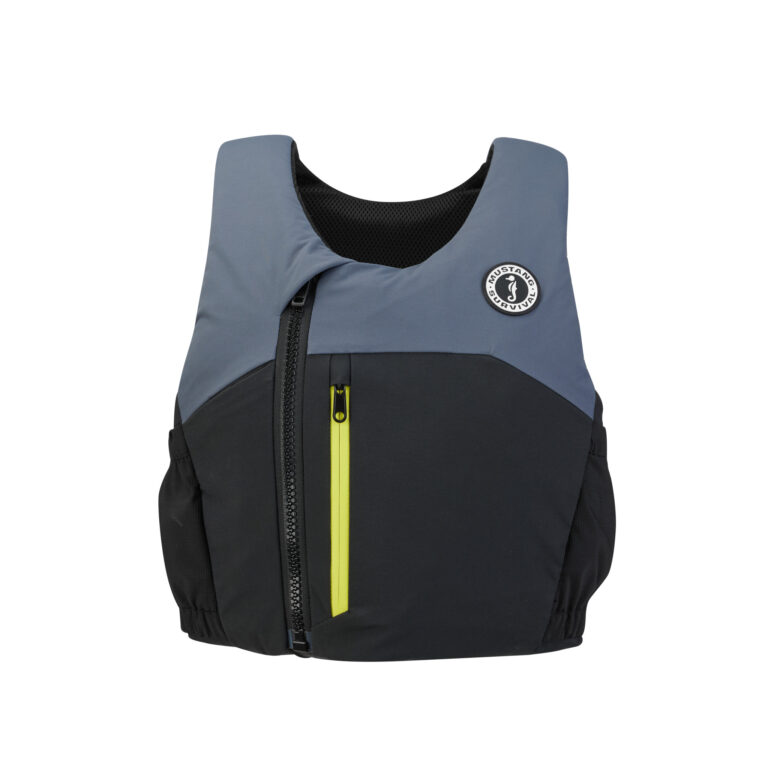
Comfort Rules with Mustang’s Minimalist Buoyancy Aid

Mistakes And Misfires On the Final Day of Cup’s Preliminary Regatta

Emirates Team New Zealand Remain the Bullies of Barcelona

Start-Box Sparring in Barcelona on Day 2 of Preliminary Regatta

- Digital Edition
- Customer Service
- Privacy Policy
- Terms of Use
- Cruising World
- Sailing World
- Salt Water Sportsman
- Sport Fishing
- Wakeboarding
Visit our Popular Forums
- Monohull Sailboats
- Multihull Sailboats
- Powered Boats
- General Sailing
- Antares Yachts
- Fountaine Pajot
- Lagoon Catamarans
Cruising Business
- Boat Classifieds
- General Classifieds
- Crew Positions
- Commercial Posts
- Vendor Spotlight
Life Aboard a Boat
- Provisioning: Food & Drink
- Families, Kids, & Pets Afloat
- Recreation, Entertainment, & Fun
- Boat Ownership & Making a Living
- Liveaboard's Forum
Seamanship, Navigation & Boat Handling
- Seamanship & Boat Handling
- Training, Licensing, & Certification
- Health, Safety, & Related Gear
- Rules of the Road, Regulations, & Red Tape
Engineering & Systems
- Const. / Maint. / Refit
- Product / Service Reviews
- Electronics: Comms / AV
- Electrical: Batts / Gen / Solar
- Lithium Power Systems
- Engines & Propulsion
- Propellers & Drive Systems
- Plumbing / Fixtures
- Deck Hdw: Rigging / Sails
- Aux. Equipment & Dinghy
- Anchoring & Mooring
Photo Categories
- Member Galleries
- Life Onboard
- Sailing in the Wind
- Power Boats
- Cruising Destinations
- Maint. & Boat Building
- Marine Life
- Scuba Diving & Divers
- General Photos
Recent Photos

Listing Categories
- African Cats
- view more »
- Crew Wanted
- Crew Available
- Enhance Your Account
- Meet the Mods
- Meet the Advisors
- Signup for The Daily Cruiser Email


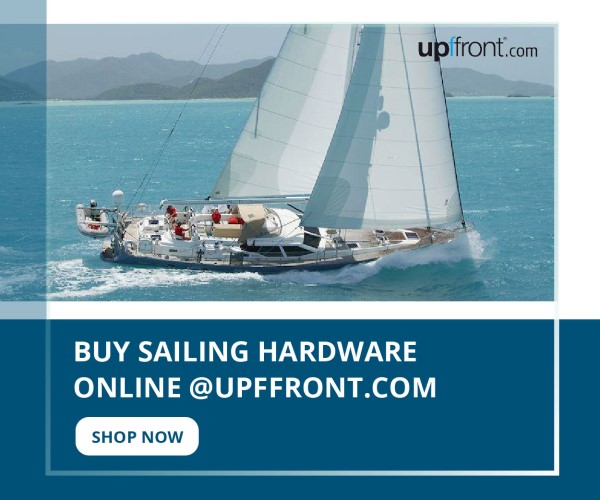
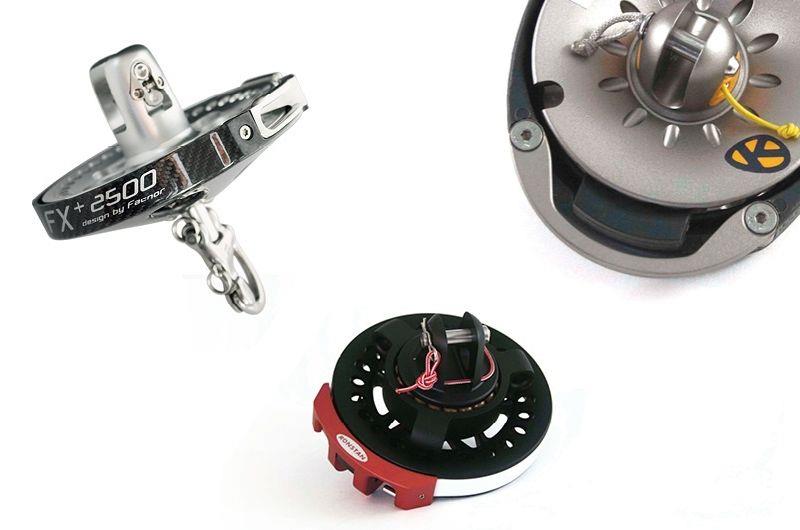
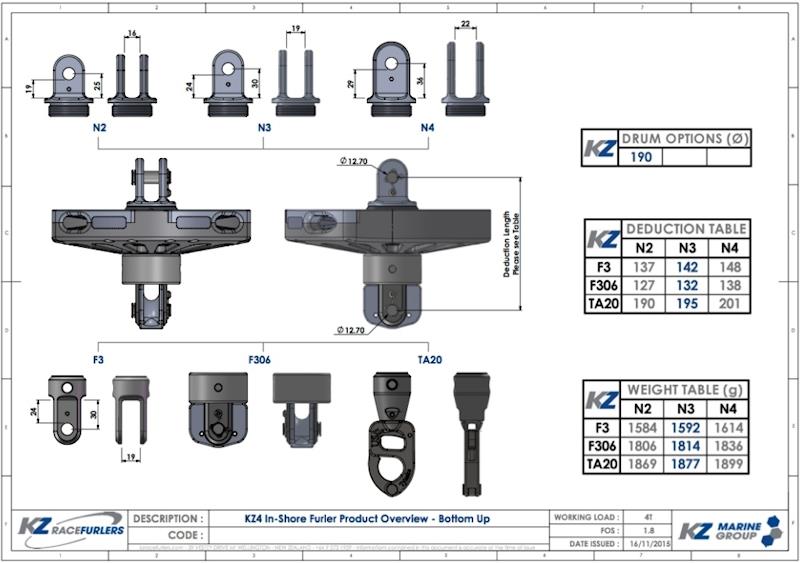
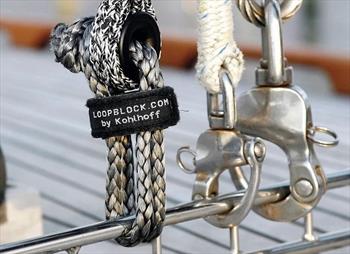

IMAGES
VIDEO
COMMENTS
Flying a Code Zero on a cruising catamaran. Handling a Code Zero sail on a modern cruising catamaran: This informative and inspiring how-to-video was made by the Australian multihull experts of TMG Yachts, after taking delivery of a new Rolly Tasker Sails Code 0.This sail was tailor made for the Lagoon 46 catamaran featured here by Rolly Tasker Sails Australia.
Catamarans and trimarans have notoriously small jibs, making them grossly underpowered in light breeze. A screecher is larger, higher clewed, and fuller than a genoa but flatter than a typical code zero. 3. A code zero is strictly a racing sail. Cruisers of all ilks have taken to the sail for its range and ease of use.
Since the Code Zero is primarily a downwind sail, tacking is not possible, as the sail is hoisted in front of the forestay, instead you must gybe. For a cruising gybe, start by heading downwind to reduce the apparent wind on the vessel. Ensure the furling line is ready, and as the sail is eased, furl the sail, then prepare to gybe the boat.
We had high hopes for the Code Zero...the sail is an incredibly popular setup on newer boats. The idea of making good time with the sails instead of firing u...
The Code 0 for cruising monohull sailboats is a full sail, shaped like an asymmetrical spinnaker, and furls easily on a top-down furling system. While the midgirth of the racing Code 0 is restricted to at least 75% of the foot length, the cruising version of the sail has no restrictions, giving the sailmaker a lot of leeway in design.
Code Zero sails have a 75% mid girth but are as flat as possible to hit those close reaching angles, so they help fill the gap between upwind headsails and downwind spinnakers. If you are looking to optimize your inventory, having adding Code Zero sail in the mix is a win-win. They aren't just for racers; the Helix Furling Gennaker is a ...
A Code Zero has a mid girth of 75% of the foot length, so it measures as a spinnaker but has a much bigger area than a genoa. The optimal wind speed for this sail is 3 to 18 knots true wind speed and in lighter winds, you can carry this sail up to a 45-degree true wind angle. Typically they are designed to be flatter than a spinnaker and have a ...
The Code 0 is a kind of large, very light genoa that can be sent in the manner of an asymmetrical spinnaker or as a gennaker. This sail allows to tighten the wind in very light winds. With blocked materials such as laminated fibres and a fairly flat design you will almost be able to sail upwind. On the other hand, a slightly flexible fabric and ...
How easy is it to set up a code zero single handed on a modern catamaran? See for yourself as I film the owner of Lagoon 42 Wanda doing it on a sunny day in ...
After all, this is how we actually sail! In this video, David defines the parameters of a code zero and discusses the evolution of code sail designs. He dives into Quantum's line of AWA sails and discusses the different models - AWA 40, AWA 60, and AWA 80. Request a quote now or get in touch with one of our sail consultants if you still have ...
You can typically use a cruising code zero from 70° true wind angle (TWA) in very light air up to 110° TWA in 15+knts. Ultimately it depends on the righting moment of your boat and how comfortable you are with how much the sail may make your boat heel in significant breeze or at tighter angles. Most cruising code zeros are designed primarily ...
5. A Code 0 is strictly a downwind sail. A Code 0 is classified as a spinnaker in terms of racing, hence the restriction on the length of the midgirth, but it's not a true downwind sail. If you're going downwind, you'll use either a symmetrical or asymmetrical spinnaker.
The Quantum Code 0 for cruising monohull sailboats is a full sail, shaped like an asymmetrical spinnaker, and furls easily on a top-down furling system. While the midgirth of the racing Code 0 is restricted to at least 75% of the foot length, the cruising version of the sail has no restrictions, giving the sailmaker a lot of leeway in design.
The Code Zero is a much flatter "triangular" shaped sail that is designed for close reaching. The Cruising Spinnaker is bigger and rounder and designed for broad reaching. The Code zero runs wind angles from 50-110 degrees. The Code D. The Code D is a cruising spinnaker with a nearly straight luff that furls from the bottom up, just like a ...
Code Zero sails are most effective between 80 to 125 degrees true-wind angle, in windspeeds of 5 to 18 knots. However, it's important to remember that the Code Zero is measured as a spinnaker.
Re: Screecher vs. Code 0- Help Deciding. The first question to answer is what do you want to use it for in terms of making your sail inventory more well rounded. More specifically, what wind ranges, & wind angles do you want to use it in. There's an example of drawing up a grid of what sails are flown in specific wind ranges & angles at Beth ...
Code 0's can be also Optimized to 60 - 140 degrees apparent wind angle (AWA), Approximately 70-75% of the sail area of a full-size spinnaker. Mid girth measurement 75-85% of foot length. Our code 0's are CAD drawn and presented to you before production Code 0's come with 4 color option standard (certain cloths have limited color choice)
A bigger drum provides more torque / power which will be useful for a heavier, larger code zero. A smaller drum delivers more speed - an essential component to successful top-down furling (N.B. the smaller the drum the more power and line speed you need to be able to generate from either your winches or your arms - depending on boat size!) Lock ...
Construction Symmetric and asymmetric off-wind cruising sails are often made of nylon fabrics in .75-ounce, 1.5-ounce, 2.2-ounce (sometimes called Force 9) weights. Polyester fabric, such as Dacron, is often used for Code 0 sails in weights that can range from 1.9 ounce through 4.5 ounce.
HOW TO SAIL TRIM, TACK AND GYBE AS WELL AS USE A CODE-ZERO ON A CATAMARAN. For this episode, we had Sam Newton, Americas Cup and Sail GP pro sailor and owner...
Cruising Code Zero for non-overlapping boats. Apparent wind angle: 45-110 degrees. Apparent wind speed: 1-16 knots. Approximately 60% of the sail area of a full-size spinnaker and about twice the size of a non-overlapping genoa. Use with a "top down" roller/furler with a torsion rope sewn into the sail.
Our cruising experts discuss various styles of Code Zero's. This webinar is perfect for shorthanded sailors, performance cruisers, or those looking for more ...
Catamaran type Code 0's are called Screechers and specially made for catamarans. Screechers are designed a little more flat than a code 0, due to the design of the Catamaran and their sails. Fareast sails Screechers are fully customized with your sailing style in mind. Screechers are radial cut for optimal performance.